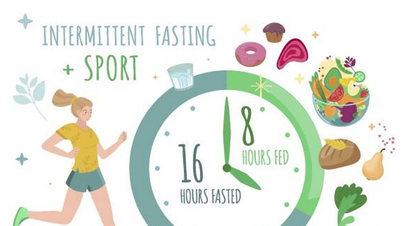It seems that since ancient times, mankind has been searching for the path to the “fountain of youth,” ways to ensure a longer and healthier life.
And while we may not yet benefit from any miracle drugs or technologies to extend our lifespans beyond the one-hundred-year mark, numerous recent studies have provided strong evidence to support the notion that simple lifestyle changes can help us stay healthy longer and reduce our risk of premature death.
For example, research presented at the American Heart Association's 2023 Scientific Sessions found that eight healthy habits can slow biological aging by up to six years.
These habits involve diet, maintaining a healthy weight, avoiding tobacco, maintaining good sleep hygiene, controlling cholesterol, blood sugar and blood pressure, and, no less important, staying physically active.
Regular exercise has many health benefits (Illustration: Shutterstock).
In a conversation with Medical News Today, Dr. Borja del Pozo Cruz and Dr. Edwina (Eddie) Brocklesby shared the link between exercise and living a long, healthy life.
Dr. del Pozo Cruz is a principal investigator in applied health sciences at the University of Cadiz in Spain and a visiting associate professor in the Department of Sports Science and Clinical Biomechanics at the University of Southern Denmark.
Dr Brocklesby is known as the "Iron Gran" because, at the age of 72, she is the oldest British woman to complete an Ironman triathlon.
It's no surprise that staying physically active can help keep you healthy and add years to your life. Exercising every day can help you reap the benefits, adding up to 3 years to your life. What's more, your risk of premature death can drop by 4% for every 15 minutes of daily physical activity.
A recent review found a 22% lower risk of premature death in people over 60 who exercised even though they did less than the recommended 150 minutes per week. Those who met the recommended 150 minutes had a 28% lower risk of premature death.
What types of exercise reduce the risk of death?
In a study published in JAMA Internal Medicine in August 2023, Dr. del Pozo Cruz and colleagues analyzed data from 500,705 participants followed for an average of 10 years to see how different forms of exercise were associated with a person's risk of death.
The study looked at the effects of moderate aerobic physical activity such as walking or light cycling, vigorous aerobic physical activity such as running, and muscle-strengthening activity such as weight lifting.
Aerobic physical activity is endurance exercise in which muscles work in coordination and rhythmic motion for a long period of time. It increases heart rate and breathing to supply more oxygen to the muscles.
Researchers found that a balanced combination of all these forms of exercise was most effective in reducing the risk of death.
More specifically, about 75 minutes of moderate aerobic exercise, plus more than 150 minutes of vigorous exercise, along with at least a few sessions of strength training each week were associated with a reduced risk of death from all causes.
When it comes to reducing the risk of death related to cardiovascular disease, Dr. del Pozo Cruz and colleagues recommend combining a minimum of 150-225 minutes of moderate physical activity with about 75 minutes of vigorous exercise and two or more strength training sessions per week.
How little exercise is enough?
But what about people who aren't very athletic? What's the minimum amount of exercise that can help combat some of the conditions that pose the biggest threat to health?
Dr. del Pozo Cruz and his team may have found the answer to this question, too. In December 2022, they published the findings of a previous study in the European Heart Journal.
This study found that doing just 2 minutes of vigorous exercise a day can help reduce the risk of death from cancer or cardiovascular events.
Researchers found that study participants who never did any vigorous exercise had a 4% risk of death within five years, but that doing less than 10 minutes of vigorous exercise a week cut that risk in half. What's more, their risk of death was halved for those who exercised at least 60 minutes a week.
Is there any good physical activity?
Dr. del Pozo Cruz emphasizes that almost any amount of exercise is better than none, a view reinforced by new research that suggests any activity is better for heart health than a sedentary lifestyle.
Source: https://dantri.com.vn/suc-khoe/chia-khoa-song-tho-don-gian-ai-cung-lam-duoc-20250709073432702.htm





![[Photo] Red flag with yellow star flutters in France on National Day September 2](https://vphoto.vietnam.vn/thumb/1200x675/vietnam/resource/IMAGE/2025/8/28/f6fc12215220488bb859230b86b9cc12)
![[Photo] General Secretary To Lam attends the opening ceremony of the National Achievements Exhibition](https://vphoto.vietnam.vn/thumb/1200x675/vietnam/resource/IMAGE/2025/8/28/d371751d37634474bb3d91c6f701be7f)

![[Photo] National Assembly Chairman Tran Thanh Man holds talks with New Zealand Parliament Chairman](https://vphoto.vietnam.vn/thumb/1200x675/vietnam/resource/IMAGE/2025/8/28/c90fcbe09a1d4a028b7623ae366b741d)
![[Photo] Politburo works with the Standing Committee of Cao Bang Provincial Party Committee and Hue City Party Committee](https://vphoto.vietnam.vn/thumb/1200x675/vietnam/resource/IMAGE/2025/8/28/fee8a847b1ff45188749eb0299c512b2)































































































Comment (0)